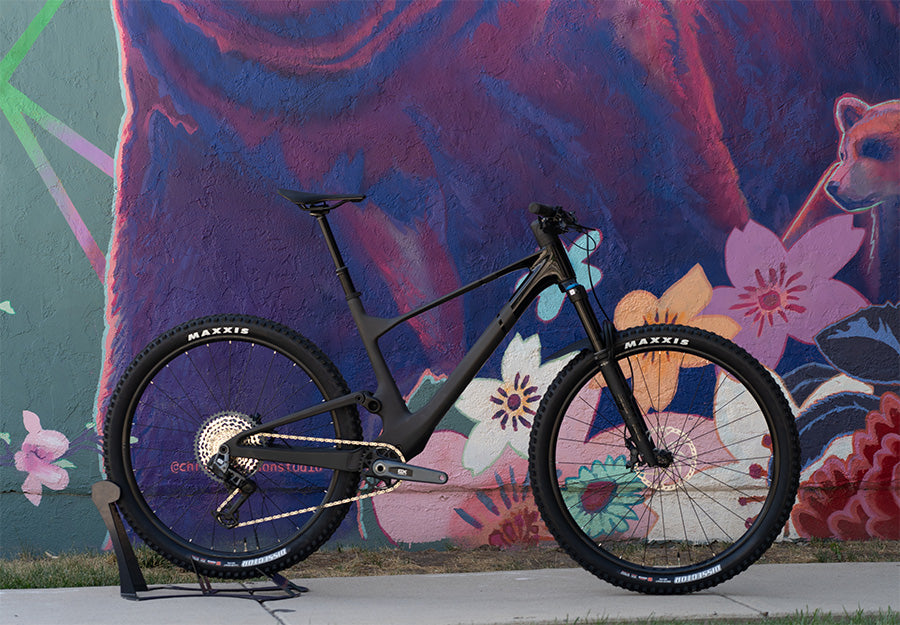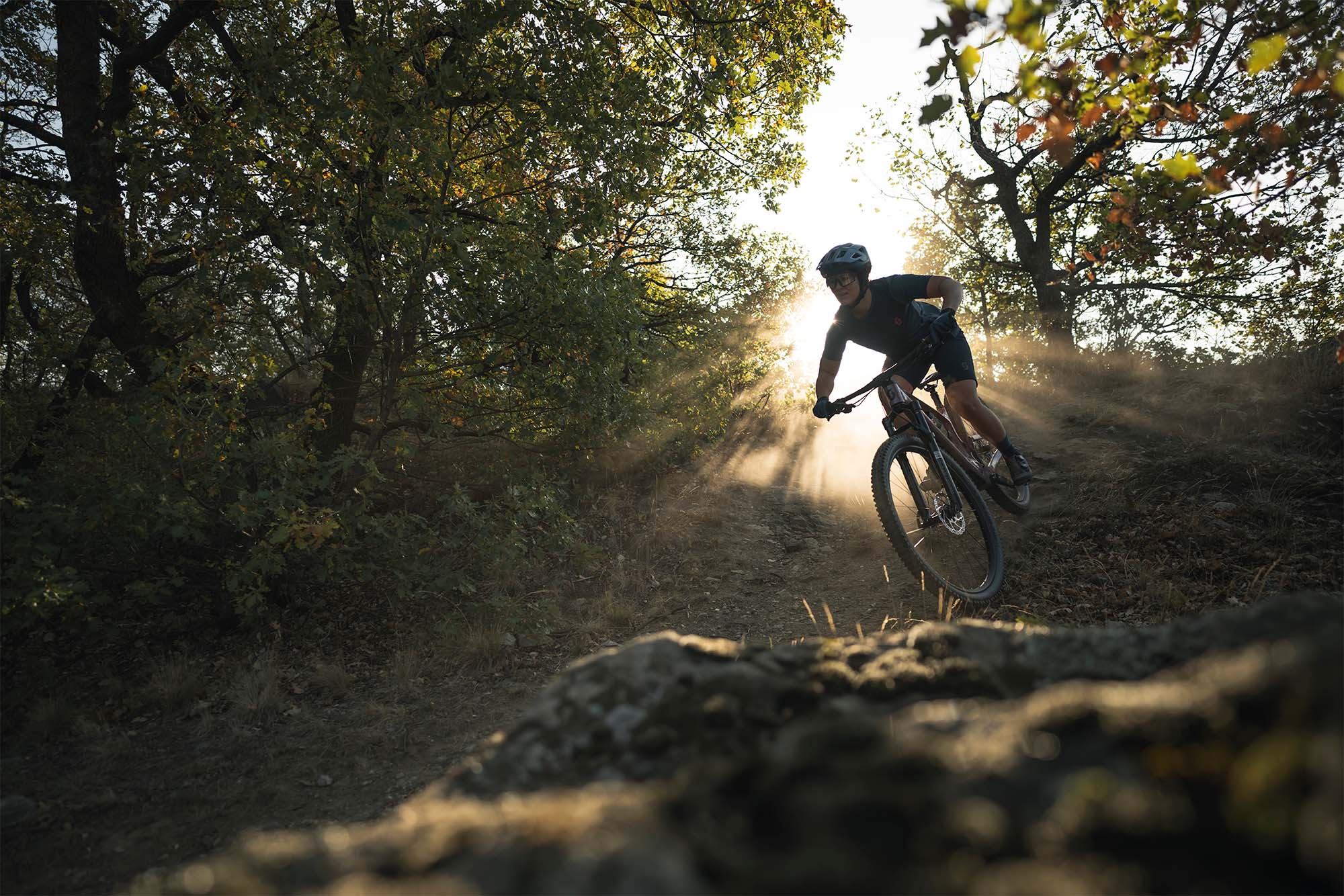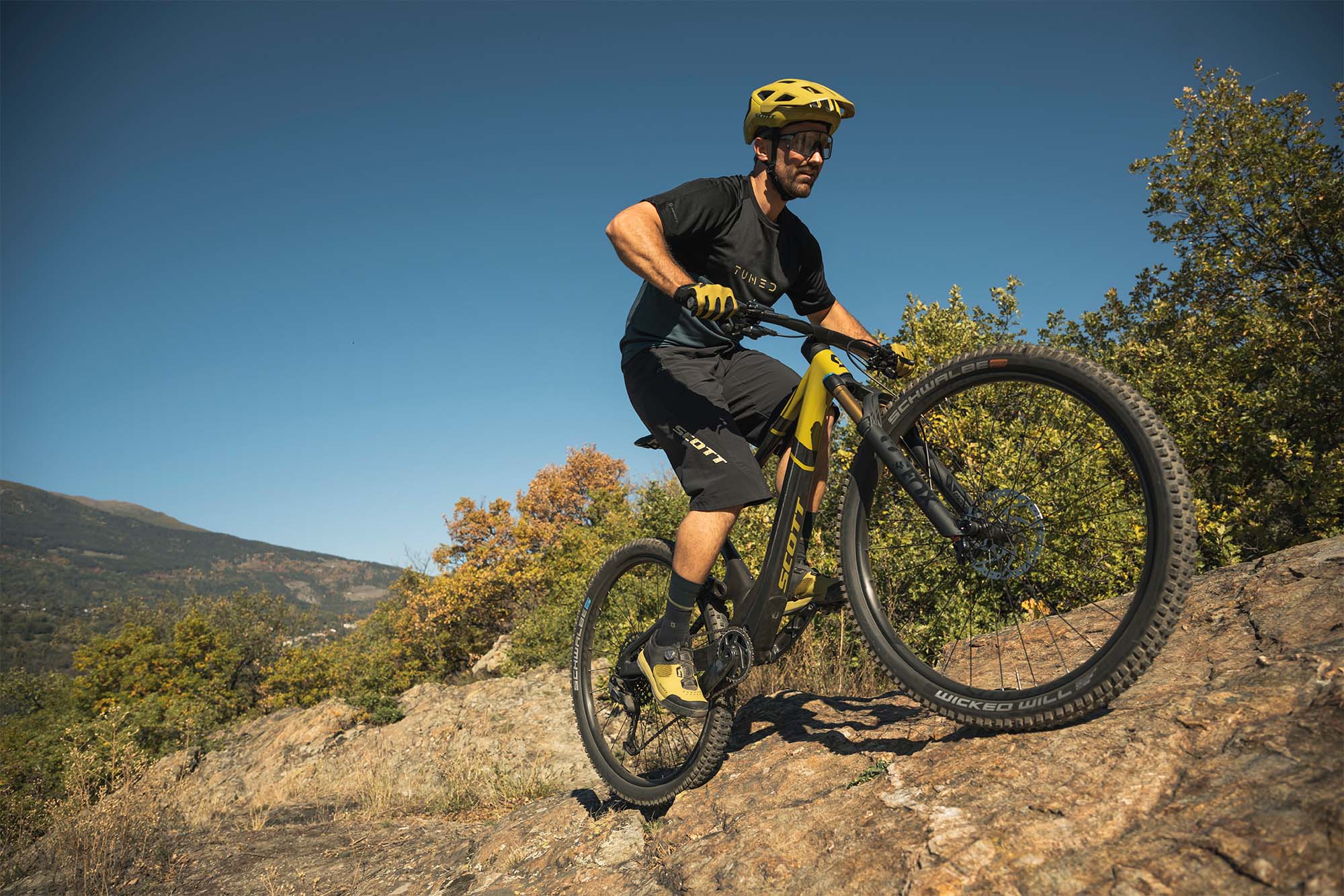The SCOTT Spark has undergone a significant redesign over the years, solidifying its position as one of the most successful XC race bikes. With a robust feature set and carefully crafted geometry, the Spark continues to excel. Our enthusiasm matches yours as we explore the noteworthy features and updates across the Spark RC and the Spark 900 trail bike.

Your Inside Guide to the SCOTT Spark, Spark RC, Spark ST, and Contessa Spark
SEE SCOTT SPARK and SPARK RC IN STOCK

A Bold Redesign
Years ago, SCOTT purchased a majority share of a small Swiss company called Bold Cycles. We had one of their most interesting bikes, an Unplugged V2, on display in the shop for a bit. It generally received comments along the lines of “that thing ISN’T an electric bike?” and “where does the shock go?” While this bike may indeed share some design cues with the Bold, SCOTT asserts that these features were developed independently of the company.
The shock placement is objectively the most polarizing piece of the bike. SCOTT calls this Integrated Suspension Technology, but the shock layout is the same single-pivot suspension as used before. Really, the most important thing to note that SCOTT was able to move the shock lower than almost anything else out there.
There are a number of benefits to placing the shock lower, both in performance and practicality. Lower shock placement in the stiffest part of the bike means SCOTT could increase frame stiffness around the bottom bracket - where it's needed the most - for both the shock and bottom bracket. Two birds with one stone, and it's no heavier as a result. Bringing the shock lower also means SCOTT was able to use bearings as opposed to bushings in the linkage to better withstand dirt and grime that might accumulate.
As you’d imagine, there are also a ton of practical benefits to the internal shock mount. The bike comes with easily removable covers so riders can easily check sag, adjust rebound and compression, or remove the shock outright. The result is a shock completely protected from the elements but still easily accessible. And should you not want to remove any covers, there is a line indicator on the non-driveside upper seattube pivot that makes checking sag easy.
Besides that, it is the same trunnion-mount single-pivot shock setup that has allowed the Spark to work as well as it does. Like before, it features a one-piece rear triangle that relies on seatstay flex to help guide the shock through its travel. It might look wildly different than any other cross country mountain bike, but it is suspension you've come to expect from SCOTT, just with some benefits.
Wait, More Suspension?
SCOTT receives a lot of input from their racers, notably Nino Schurter, the winningest XC MTB racer in recent memory. He’s been riding a Spark RC with a custom linkage that bumped up travel to 115mm, and he - alongside Kate Courtney and their other racers - wanted more travel to tackle the toughest XC courses. We all benefit as a result.
The Spark RC and Spark 900 both sport 120mm rear suspension travel, a noticeable bump up from the previous 100mm rear shock travel, and the same as the 2021 Spark 900. The pros (and the semi-pros among us) will take the lighter 120/120mm Spark RC, while those looking for a bit more of a forgiving setup will go for the beefed-up 130/120mm Spark 900.
To note, Spark RC models receive smaller-volume shocks that are set up a bit more linear, while Spark 900 bikes receive a larger-volume, more progressive shock.
120mm is more than what we’re accustomed to seeing on our favorite cross country bikes, but more and more people are choosing the beefed-up trail models of these bikes. To us, this is a logical change, not only for everyday riders like us but for racers looking for the fastest line through a rock garden.

Geometry
Of course, more suspension travel also means that SCOTT had to mix up geometry, and we’d consider this a pretty big mixup to the cross country market.


To start, the Spark RC and Spark 900 share the same frame, but thanks to an adjustable-angle headset, riders can change their head angle according to their needs. All of this can be done without removing any cables or housing. Check out the geometry chart above for the full details, but compared to the previous model, you're seeing a head angle that is 1.3 degrees slacker, up to a substantial 65.9-degree angle on the Spark 900. Seat angles are as steep as 76.9 degrees in a Spark RC size XL.
Reach measurements grow by 15mm on each size and stem lengths have shortened my 10mm across the board to complement it. Unfortunately, standover heights have increased to 758mm in size small. This is still lower than a lot of other bikes, but it is something of note particularly for smaller riders.

Frame Features
SCOTT put a lot of work into ensuring the internal shock setup would work neatly with the rest of the bike, and so you’d figure that they’d call it a day once they got that dialed, right? Not so. Integration made it's way from the rear shock up front, with semi-internal cable routing up front. Cables enter to the sides of the stem, through the headset, and into the downtube. It is a clean look that helps clean up the mess of cables that tend to come with a dropper post and Twinloc. More on that in a moment.
There are tons of new integrated internal routing setups from SCOTT depending on price point, from alloy bar and stem options all the way up to an updated Syncros Fraser iC SL handlebar. The Fraser iC handlebar now comes in three iterations: Fraser iC SL XC, iC SL, DC, and iC SL WC. XC models (for cross country, we’re sure) are found on most high-end Spark RC models with varying lengths, while DC (for down country, thanks Pinkbike!) swaps to a zero-degree stem and wider bar widths. Then there’s the Fracer iC SL WC bar, which was made specifically for the SCOTT-SRAM MTB team. There is a choice of everything from a -40 degree rise to a -20 rise. Total weight for the bar and stem is 265 grams with hardware.

You also get an updated look at Twinloc, SCOTT’s long-running dual suspension remote. The latest version of the remote uniquely adjusts compression, travel, and geometry to firm up the suspension at the push of a button. Here, however, you get a few changes. First and foremost, Twinloc no longer requires a unique grip mount as before, but instead uses SRAM Matchmaker mounts for a clean mounting setup.
Further, the latest version adds a third lever for the dropper post. The dropper lever, found on the bottom of the stack, is slightly staggered behind the suspension levers to prevent accidental lockouts or post drops. Good job SCOTT!

The Spark 900 and Spark RC both receive rubberized chainstay and seatstay protection, as well as protection around the chainstay to protect the frame against potential chain drops. The hatch that provides access to the rear shock is a hardened plastic that provides some bottom bracket protection.
All Spark models regardless of build fit a massive 2.6” tire while working with up to a 40t chainring, perfect for Nino and the Nino-wannabes out there. You also get plenty of room for a frame pack in the main triangle for long days or bikepacking as well as space for two water bottles on size M and up.

Contessa Spark And Spark ST Available Too!
SCOTT has always done well in offering a women’s-specific option through SCOTT Contessa, and the Spark falls right in line. All models receive women’s specific touchpoints like grips and saddle, as well as unique paint schemes. But besides that Contessa models receive the same new features and updated geometry that everyone can benefit from.
The SCOTT Spark ST is a new addition to the Spark lineup that brings extra composure on the descents. It takes the standard Spark - a capable, if lightweight trail bike - and adds some burliness. This comes in the form of uprated suspension. Both the Spark ST Tuned and Spark ST 910 feature a 140mm fork for extra traction. They also receive custom Fox Float X shocks unique to the Spark ST. These shocks are still rated to 120mm travel, but the piggyback oil reservoir means better performance on long, rowdy descents.
Spark ST also receives SCOTT's new TracLoc suspension remote. This remote provides a three position lockout to only the shock and not the fork. If you value pedaling efficiency but want to keep the fork settings separate from your shock, the Spark ST is the trail bike for you.

SCOTT Spark Frame Weights
We won’t go into detail on the wide 20+ model range of Spark model that starts at the Spark 970 and go all the way up a fully-loaded Spark RC SL EVO AXS. That said, here’s the breakdown on frame weights from the top-spec model all the way to the alloy entry point:
- HMX SL - 1870g
- HMX - 1990g
- HMF - 2150g
- HMF frame, alloy swingarm - 2590g
- Alloy 2990g
HMX SL frames are available on the Spark RC SL EVO AXS bikes, while HMX frames are available for Spark RC World Cup and Spark 900 Ultimate EVO. All other Spark RC models sport an HMF carbon frame and swingarm. Select Spark and Spark ST models receive a full carbon HMF swingarm, while other models receive either a combination of carbon and alloy or a full-alloy frame.
Availability
The SCOTT Spark is one of our favorite mountain bikes available. Its wide range of build kits, features, and top-end tech make this MTB and easy recommendation. Be sure to check with us for the latest in availability, ship dates,
See the full range of Spark models, and contact us today with any questions or to pre-order your own SCOTT Spark.
Any clue on availability? I am wanting to get one, but afraid to commit to an order if they won’t show up for a year. Thanks!
Austin on
Rob,
while SCOTT hasn’t officially said whether or not they’ll offer a frame-only version of the Spark, I suspect they’ll have something eventually. They certainly offered multiple Nino special editions. If they do offer one, we’ll make sure to share it with you all!
Alvin - Contender Bicycles on
Curious if the RC will be offered in a frame/fork/cockpit option?
Rob on
Hi Chris! We haven’t had the chance to ride one for ourselves quite yet – and frankly that might until the end of summer when we can. That said, I think we can make a few inferences based on its design and what they’ve shared.
I don’t think the new Spark RC will have a substantially more progressive tune than your current bike. Based on the shock being mounted farther back, there should be less pedal feedback into the suspension, which should allow the rear suspension to be just a bit smoother through small bumps. The Spark and RC receive different shocks; Spark apparently will be getting a higher-volume version of the Fox EVOL the Spark RC receives. We’ll see what that changes but it should be just a touch more capable.
Alvin - Contender Bicycles on
I’m riding a 2019 Spark 900 Premium, with the grey frame w/ red highlights, 120mm of kashima Fox suspension, XTR, etc. It’s interesting how close the new RC looks to my bike on paper. Can you comment on how the suspension tune should differ between the bike I’m riding and the new RC? Or on whether the new Spark 900 will have a substantially more progressive/squishy tune than my bike?
chris cawley on